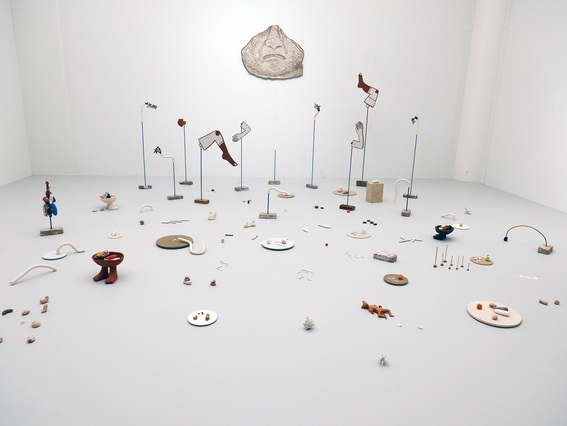
R
E
V N
E
X
T
Aichi Triennale Artists Demand Removal of Works as Government Investigates Controversy
*Last updated August 23, 2019.
The controversy over the closure of an exhibition about historical incidents of censorship of artworks in Japan continues to roil the Aichi Triennale. On August 12, more than a week after the suspension of the “After ‘Freedom of Expression’?” display at Aichi Triennale—ten artists circulated an open letter demanding the removal of their own artworks from the festival as “a public gesture of solidarity with the censored artists.” The group included seven artists from Latin America, as well as the curatorial member Pedro Reyes, and South Korean artists Park Chan-kyong and Minouk Lim, who had already announced the removal of their works earlier this month. Dora García and Ugo Rondinone subsequently also added their signatures.
As of August 20, the exhibition rooms featuring works by Tania Bruguera and Javier Téllez have been closed. Part of Claudia Martínez Garay’s and Regina José Galindo’s installations remain on site, but the lights in their respective rooms have been turned off along with the video components of their works. Dora García covered posters for her performance The Romeos (2009– ) with copies of the open letter, while Reynier Leyva Novo wrapped his sculpture in black garbage bags and obscured his paintings with newspapers featuring coverage on the closure of “After ‘Freedom of Expression’?” Pia Camil rolled up her curtain of band t-shirts, Telón de Boca (2018). Mónica Mayer’s The Clothesline (2019), which invites visitors to write about experiences of sexual abuse, has been renamed Silent Clothesline, and it now features a single note by the artist explaining the circumstances surrounding the work’s alteration, with the rest of the messages scattered on the floor. Following negotiations with the festival’s organizers, Ugo Rondinone decided to allow his installation of 40 clown figures to remain on view.
“After ‘Freedom of Expression’?” originally opened on August 1 at the Aichi Prefecture Museum of Art, in Nagoya, within the framework of the Aichi Triennale 2019, directed by Daisuke Tsuda and titled “Taming Y/Our Passion.” Among the artworks previously censored or removed from exhibitions in Japan, was a sculpture of the comfort woman created by Kim Seo-kyung and Kim Eun-sung that attracted criticism from the Nagoya mayor Takashi Kawamura. Under political pressure and terrorist threats, the exhibition was forced to shut down three days after its opening. The Triennale has received more than 770 threatening emails, as well as an anonymous fax in which the sender claimed they would bring a gas canister to the museum and burn it down. Aichi police arrested a 59-year-old man on August 7 in connection with the fax.
In response to heated debate between the exhibition’s right-wing detractors—who claim it offends national feeling—and those who defend it on the grounds of freedom of expression, Hideaki Omura, the governor of Aichi Prefecture, established the Aichi Triennale Inspection Committee on August 13. The group held its first meeting at the Aichi Prefectural Government Office on August 16 to reflect on the controversies as well as to propose a plan for what to do with the exhibition and in similar scenarios in the future. Chaired by Toshio Yamanashi, director of the National Museum of Art, Osaka, members of the Committee include Shinichi Ueyama, professor at the Faculty of Policy Management, Keio University; Junko Iwabuchi, chief editor of online media AGROSPACIA; Yoshiyuki Oshita, executive director of the Independent Administrative Institution of National Museum of Art; Tadashi Kanai, professor at the Faculty of Arts, Shinshu University; and Masahiro Sogabe, professor at the Graduate School of Law, Kyoto University.
According to a report by Japanese art magazine Bijutsutecho and Twitter posts by Omura, at the meeting, the governor emphasized the necessity of cooperation between organizers of local art festivals and the Prefectural Government in consideration of public safety. The members discussed issues including the respectful use of public venues, distribution of governmental funds, freedom of academic research and expression, and concerns over security throughout the exhibition period. The Committee eventually decided to set up a team to collect and analyze relevant information, and conduct hearings with specialists and all concerned parties. After releasing the first report in late September, the Committee will host a public forum to gather comments from citizens, artists, and curators. These decisions have been made in accordance with the wishes of artistic director Daisuke Tsuda, who previously called for a public forum in response to the controversy.
On August 25, a group of the Triennale’s participating artists, including Tsubasa Kato and Dokuyama Bontaro, will hold their own public forum addressing the questions “Why must we protect freedom of expression?” and “What can artists do to deal effectively with threats of violence and external pressure?” The discussion will be hosted by Sanatorium, a new pop-up space launched by the artists at Nagoya’s Endoji Honcho Shopping Arcade, one of the Triennale’s venues.
The press release for Sanatorium explains: “We believe that it is urgent to transcend the binary oppositions of organizing committee/artist and Right/Left which have fueled the furore. The Sanatorium has been opened for the purpose of nurturing the exchange of honest opinions to that end . . . We will also seek to develop institutional structures and the personal strength to respond concretely to threats of violence, by inviting specialists in the fields of anti-terrorism, disaster response, law, architecture, and education for instruction and debate.”
The statement concludes: “Freedom of expression is a public issue that implicates everyone, and not just artists. We firmly believe that exploring options here, in a shopping arcade that is enmeshed with the daily lives of common people, rather than within the confines of a museum, is a correct first step toward creating methods that guarantee our autonomy in the future.”
Pamela Wong is ArtAsiaPacific’s assistant editor.
To read more of ArtAsiaPacific’s articles, visit our Digital Library.













